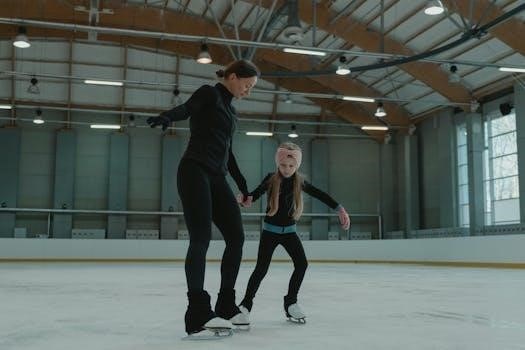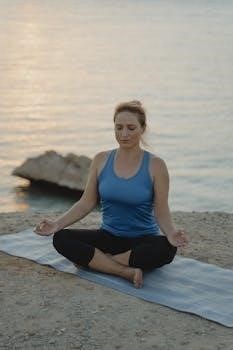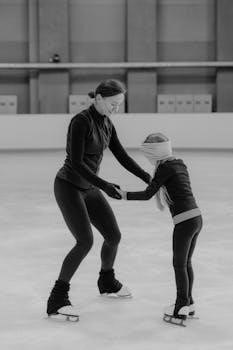Bunion Exercises⁚ A Comprehensive Guide
This guide provides a comprehensive overview of bunion exercises, addressing pain relief and slowing progression․ It incorporates techniques to enhance mobility, strength, and balance․ Lifestyle adjustments and footwear choices are emphasized․ Post-operative recovery exercises are also included to help you resume normal activities․
Understanding Bunions (Hallux Valgus)
Hallux Valgus, commonly known as a bunion, is a frequent foot ailment characterized by a noticeable bump on the inner side of the forefoot․ Bunions often result in discomfort, particularly when wearing constricting footwear․ Genetic predisposition and gradual worsening are typical features of bunions․ They arise from an imbalance in forces acting on the big toe joint, leading to its deviation towards the other toes․
This misalignment causes the metatarsophalangeal (MTP) joint to become prominent, forming the characteristic bunion bump․ The condition can affect individuals of any age, but it is more prevalent in adults, especially women․ Factors contributing to bunion development include genetics, improper footwear (high heels, narrow toe boxes), foot structure abnormalities, and certain medical conditions such as arthritis․
Understanding the underlying causes and progression of bunions is crucial for effective management․ Early recognition and intervention can help alleviate symptoms, slow down the deformity’s development, and improve overall foot health․ Non-surgical approaches, including exercises, footwear modifications, and orthotics, can play a significant role in managing bunion pain and preventing further progression․
Importance of Exercise for Bunion Management
Exercise plays a pivotal role in managing bunions by addressing pain, improving joint mobility, and strengthening supporting muscles․ Regular exercises can help alleviate discomfort associated with bunions by improving blood flow, reducing stiffness, and promoting tissue healing․ Targeted exercises focus on enhancing the range of motion in the big toe joint, preventing stiffness and adhesions, especially after surgery․
Strengthening exercises for the foot muscles contribute to better alignment and stability of the foot․ Exercises such as toe curls, toe extensions, and heel raises help build strength in the intrinsic foot muscles, improving their ability to support the arch and control foot movement․ Ankle and calf exercises are equally important as they provide support to the entire foot structure, reducing strain on the bunion․
Proprioceptive exercises enhance balance and stability, crucial for optimized load distribution during gait․ By improving the body’s awareness of foot position, these exercises help prevent abnormal stress on the bunion․ In addition, integrating gait training helps optimize load distribution across the foot, minimizing pressure on the bunion area․ Consistent exercise, combined with appropriate footwear and lifestyle modifications, can significantly slow bunion progression and improve overall foot function․
Range of Motion Exercises for Big Toe Joint
Range of motion exercises are crucial for maintaining and improving the flexibility of the big toe joint, which is often affected by bunions․ These exercises help reduce stiffness, prevent adhesions, and promote better joint function․ One simple exercise involves gently flexing and extending the big toe, moving it up and down as far as comfortably possible․ This can be performed several times a day to maintain joint mobility․
Another effective exercise is toe circles, where the big toe is rotated clockwise and counterclockwise․ This helps improve circulation and flexibility in the joint․ Toe abduction and adduction exercises, which involve spreading the toes apart and then bringing them together, also enhance flexibility and range of motion․ These exercises should be performed slowly and deliberately, avoiding any sharp pain․

Manual stretching can also be beneficial․ Gently use your hand to move the big toe into different positions, such as stretching it upwards, downwards, and sideways․ Hold each stretch for a few seconds and repeat several times․ Consistent practice of these range of motion exercises can help alleviate pain, improve joint function, and slow the progression of bunions․ Remember to listen to your body and avoid pushing beyond a comfortable range․
Ankle and Calf Exercises for Support
Ankle and calf exercises play a vital role in supporting the foot and managing bunion symptoms․ Strong ankles and calves provide stability, improve balance, and optimize load distribution, reducing stress on the big toe joint․ Regular exercises can help maintain muscle tone, strength, and mobility in these areas․ One essential exercise is ankle plantar flexion, which involves standing on your toes to strengthen the calf muscles․
Dorsiflexion, where you bring your foot upwards towards your shin, strengthens the muscles on the front of the leg․ Strengthening the peroneal muscles, located on the outer side of the lower leg, is also important․ This can be achieved by performing eversion exercises, where you turn your foot outwards against resistance․ Heel-raise exercises, performed with slight knee flexion to reduce gastrocnemius involvement, engage the muscles supporting the ankle and foot․

Initiate these exercises by stiffening and elevating your arch, while holding the hindfoot turned inward․ Incorporating these ankle and calf exercises into your routine can significantly improve foot support, reduce bunion pain, and enhance overall lower limb function․ Remember to perform these exercises with proper form and gradually increase the intensity as you get stronger․ Consistency is key to achieving optimal results․

Strengthening Exercises for Foot Muscles
Strengthening the intrinsic foot muscles is crucial for bunion management, as these muscles provide support and stability to the foot’s arch and toes․ Strong foot muscles can help realign the big toe, improve foot function, and alleviate bunion pain․ Simple yet effective exercises can be easily incorporated into your daily routine to achieve these benefits․ Toe curls, performed by using your toes to scrunch up a towel or pick up marbles, are excellent for engaging and strengthening these muscles․
Toe extensions, where you lift your toes while keeping your foot flat on the floor, target different muscle groups within the foot․ Pain-free toe and heel raises, transitioning from sitting to standing, can also contribute to overall foot strength and stability․ Resisted stepping with a TheraBand provides added resistance, further enhancing muscle strength․ Lunges and medial step-downs are more advanced exercises that challenge and strengthen the foot muscles while improving balance and coordination․
Aim to perform these exercises regularly, focusing on proper form and gradual progression․ Start with a manageable number of repetitions and sets, gradually increasing as your strength improves․ Consistency is key to building stronger foot muscles, which can lead to reduced bunion pain and improved foot function․ Remember to listen to your body and avoid pushing through any sharp or persistent pain․
Proprioceptive Exercises for Balance and Stability
Proprioception, the body’s awareness of its position in space, is essential for maintaining balance and stability, especially with bunions affecting foot mechanics․ Proprioceptive exercises help retrain the nervous system to improve foot and ankle stability, reducing the risk of falls and improving overall function․ Single-leg balance exercises are a cornerstone of proprioceptive training․ Start by standing on one leg for short periods, gradually increasing the duration as your balance improves․ You can make this more challenging by closing your eyes or standing on an unstable surface like a pillow or foam pad․

Weight shifting exercises, where you gently shift your weight from side to side and front to back while standing, help improve your awareness of your center of gravity․ Wobble board or balance board exercises challenge your balance and coordination, forcing your foot and ankle muscles to work harder to maintain stability․ These exercises can be progressed by performing single-leg stances on the board or incorporating small movements while balancing․
Regularly incorporating proprioceptive exercises into your bunion management plan can lead to improved balance, stability, and confidence in your movements․ As with any exercise program, start slowly and gradually increase the difficulty and duration as your body adapts․ Pay attention to your body’s signals and avoid pushing through any pain or discomfort․ Consistent practice of these exercises can contribute to better foot function and reduced risk of falls․
Gait Training for Optimized Load Distribution
Gait training focuses on improving your walking pattern to evenly distribute weight across your foot, minimizing stress on the bunion․ Proper load distribution can alleviate pain and prevent further bunion progression․ A key element of gait training is mindful walking․ Pay attention to how your foot strikes the ground, ensuring a heel-to-toe motion․ Avoid favoring the inner or outer edge of your foot․
Focus on maintaining an upright posture, engaging your core muscles, and swinging your arms naturally․ Correct any limping or shuffling․ Using a mirror or having someone observe your gait can provide valuable feedback․ Practice walking on different surfaces, such as carpet, pavement, and grass, to challenge your balance and coordination․
Strengthening exercises for your feet and ankles, as described in other sections, will support proper gait mechanics․ If you have significant pain or gait abnormalities, consult a physical therapist or podiatrist for personalized gait training․ They can assess your gait, identify problem areas, and provide specific exercises and cues to improve your walking pattern․
Consistent practice of gait training exercises can lead to a more efficient and comfortable walking pattern, reducing stress on the bunion and improving overall foot health․ Remember to wear supportive shoes during gait training and throughout your daily activities․
Lifestyle Modifications and Proper Footwear
Lifestyle modifications and proper footwear are paramount in managing bunions and alleviating pain․ Choosing the right shoes can significantly reduce pressure on the bunion, preventing further aggravation․ Opt for shoes with a wide toe box that allows your toes to move freely without constriction․ Avoid pointed or narrow shoes that squeeze the toes together․
Look for shoes with good arch support to distribute weight evenly across your foot․ Cushioned soles can also help absorb shock and reduce impact on the bunion․ Consider wearing orthotics, custom-made or over-the-counter, to provide additional support and alignment․ Avoid high heels as they shift weight onto the forefoot, exacerbating bunion pain․
In addition to footwear, consider other lifestyle adjustments․ Maintain a healthy weight to reduce stress on your feet․ If you stand for long periods, take frequent breaks to rest your feet․ Consider using bunion pads or cushions to protect the bunion from rubbing against your shoes․ These can be found at most pharmacies․
Incorporate regular foot exercises into your routine to maintain flexibility and strength․ Avoid activities that aggravate your bunion․ If pain persists, consult a podiatrist for further evaluation and treatment․ Making these lifestyle changes can help manage bunion symptoms and improve your overall foot health․
Pain Relief Techniques⁚ Ice, Elevation, Compression
When bunion pain flares up, employing simple pain relief techniques can offer significant comfort․ The R․I․C․E․ method—Rest, Ice, Compression, and Elevation—is a widely recommended approach to reduce inflammation and alleviate discomfort associated with bunions․ These techniques are particularly beneficial after activity or when experiencing acute pain․
Applying ice to the affected area helps to numb the pain and reduce swelling․ Use an ice pack wrapped in a towel for 15-20 minutes at a time, several times a day․ Avoid direct contact between the ice and skin to prevent frostbite․ Elevation involves raising your foot above heart level to minimize swelling․ This is particularly effective when combined with ice․
Compression can further reduce swelling and provide support to the joint․ Use a flexible bandage, ensuring it’s not too tight to avoid restricting circulation․ Remember to remove the bandage before sleeping․ Rest is crucial to allow the inflamed tissues to heal․ Avoid activities that aggravate the bunion until the pain subsides․
These techniques are easy to implement at home and can provide temporary relief from bunion pain․ However, they are not a substitute for professional medical advice․ If your pain persists or worsens, consult a podiatrist for further evaluation and treatment options․ Incorporating these methods can significantly improve your comfort․
Post-Surgery Exercises and Recovery
Following bunion surgery, a structured exercise program is crucial for optimal recovery and to regain full function of the foot․ The primary goal is to reduce stiffness, improve range of motion, and strengthen the surrounding muscles․ These exercises should be initiated under the guidance of a physical therapist or podiatrist, following their specific instructions and timelines․
In the initial phase, focus on gentle range-of-motion exercises for the big toe joint․ This may involve simple flexion and extension movements to prevent stiffness and adhesions․ Ankle pumps, moving the foot up and down, promote circulation and reduce swelling․ As healing progresses, strengthening exercises are gradually introduced․
Toe curls, using marbles or towels, help to rebuild the intrinsic muscles of the foot․ Heel raises, both seated and standing, strengthen the calf muscles, which provide support to the ankle and foot․ Balance exercises, such as single-leg stands, improve stability and proprioception․ Gait training is essential to relearn a correct walking pattern, ensuring even weight distribution across the foot․
It’s vital to listen to your body and avoid overexertion, gradually increasing the intensity and duration of exercises․ Pain is a signal to stop and rest․ Regular icing, elevation, and compression can help manage any post-exercise swelling or discomfort․ Adherence to the prescribed exercise program, combined with proper care, will contribute to a successful and faster recovery after bunion surgery․
